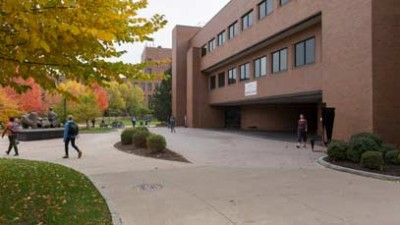Center for Public Safety Initiatives

The RIT
Center for Public Safety Initiatives
- RIT/
- College of Liberal Arts/
- About/
- Center for Public Safety Initiatives
Center for Public Safety Initiatives
Department of Criminal Justice
Rochester Institute of Technology
93 Lomb Memorial Drive
George Eastman Hall, Room 2189
Rochester, NY 14623-5603
CPSI@rit.edu
(585) 475-6386
RIT's Center for Public Safety Initiatives researches, analyzes, and promotes strategies that advance safety, justice, and crime reduction.
In partnership with regional community-based organizations and law enforcement agencies, the City of Rochester, and RIT's Department of Criminal Justice, the Center for Public Safety Initiatives (CPSI) provides vital research and analysis that support effective strategies, policies, and programs to reduce violence and enhance the administration of justice.
Bright, driven, curious, and tech-savvy, RIT graduate and undergraduate students, led by CPSI researchers and faculty, participate at all phases. From data collection to presentation of findings and recommendations, students develop on-the-job skills and experience as well as valuable career networking connections that advance career success.
CPSI staff and students support the production and translation of scientific knowledge through the publication of research studies and dissemination of CPSI working papers.
Current Projects and Working Papers
The Center for Public Safety Initiatives is a partner and a strategic problem-solver that works alongside local and community partners to find solutions to today's most pressing challenges. At our Current Projects page, read more about efforts now underway, such as the Jefferson Avenue Placemaking project and project CERV.
From analysis of crime data to the effectiveness of programs aimed at crime and victimization reduction and more, the Center's extensive collection of working papers provides timely and valuable insights to support progress in crime reduction and policy making. Papers are published throughout the year and distributed widely. At our Working Papers page, browse the collection and sign up for the email distribution list.
Research Labs and CoLabs
Bringing together creative thinkers and diverse perspectives to research, analyze, and discover solutions to today's challenges, CPSI's interdisciplinary collaboration labs include:
- Family Health and Justice Lab, a CPSI CoLAB with the RIT Department of Psychology
- Race and Justice Lab, a CPSI CoLAB
- Technology and Public Policy Lab and Crime and Digital Assets Clinic, a CPSI CoLAB with the RIT Department of Public Policy
About the CPSI
At the Center for Public Safety, we believe that:
- An individual's compassion and empathy for others obligates one to a commitment to the cause of social justice.
- Citizens deserve public institutions that operate efficiently, effectively, and transparently, leveraging best practices in an unyielding effort to improve.
- Everyone, regardless of race, sex, gender identity, sexual orientation, economic class, or other category, deserves a safe community to live in, and to live free from fear of victimization.
- The world is not just, and is not safe, and is not free from victimization, so we must find ways to change those conditions.
- If you are an academic, and you care about social justice, you must find ways to engage practitioners to do work that helps them, and that if you are a practitioner, you must seek out ways to improve your organization through research and analysis.
- To make these changes, research should be action-oriented, so that it can be applied to practical problems of the real world.
- Science can be used for great good, but can also be manipulated, so your work must always be methodologically rigorous and of the highest ethical standard.
- You do good work because it is important to you, and you care about it.
-
And lastly, but perhaps most importantly, you seek to change the world not only by influencing organizations and systems, but by enlisting people to the cause through teaching and mentorship.
Partnering for Solutions
CPSI provides program evaluation, data analytics, and project management services to area law enforcement, community non-profits, and other criminal justice professionals, and it contributes to general knowledge generation of the nature and causes of crime and violence.
Additionally, the Center for Public Safety Initiatives administers the Monroe Crime Analysis Center and the North Country Crime Analysis Center as part of an agreement with the NYS Division of Criminal Justice Services.
It also actively seeks projects where it can bring to bear its unique partnerships, research skills, and educational commitments.
Educational Goals
Its educational goals include training graduate and undergraduate students in strategic planning, program evaluation, and policy analysis.
Action Research
The foundation of the Center is the practice of action research in which relevant data and analyses are brought to bear on the day-to-day decision-making processes of organizations.
The Center serves the practice of policy development and implementation in real time and is a testing ground for 21st century university engagement, demonstrating how rigorous research and analysis can play a role in improving the lives of society’s most marginalized citizens. Its research primarily focuses on:
- Understanding violence and crime.
- The impact of violence on the broader community.
- Program evaluation of projects to reduce violence and crime.
- Intersections between criminal justice, technology, and society.
- Research examining the administration of justice and the impact of justice processes on society.
Leadership, Researchers, and Team
Innovative, insightful, and tirelessly committed, RIT's Center for Public Safety Initiatives team creates new possibilities for the criminal justice industry through its research, collaboration, and work. Undergraduate and graduate students may participate in research through the Center. To learn more, connect with the center director at ixagcj@rit.edu.








